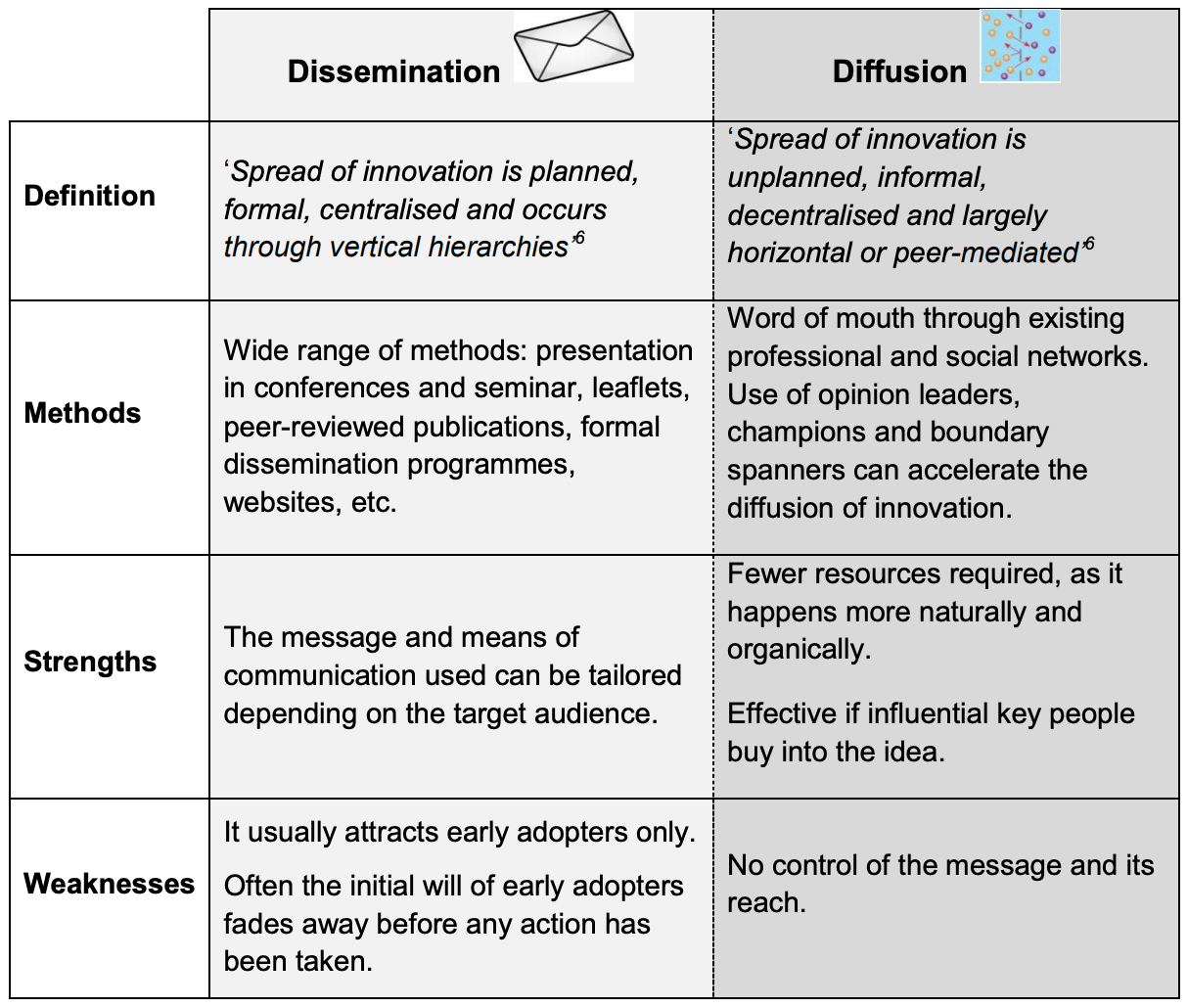Start improving with Life QI today
Full access to all Life QI features and a support team excited to help you. Quality improvement has never been easier.

Organisation already using Life QI?
Sign-up

Published on 7 September 2021 at 11:49

In this article we’re going to look at the types of ‘spread’ used in Quality Improvement (QI). In particular, we compare diffusion and dissemination. We’re going to examine how you go about disseminating and/or diffusing innovations in QI and look at how- even though the two approaches are on either ends of the spectrum - they do not have to be independent of each other.
In most cases, a combination of both approaches - diffusion and dissemination - is the ideal solution to accelerate and sustain spread. This article will consider both approaches in isolation, compare them and investigate using both methods in tandem.
First of all, let’s take a look at how we define diffusion, and the pros and cons of diffusing innovation. Health Improvement Scotland have written an extremely helpful ‘Guide to spread and sustainability’ that talks about diffusion. This guide identifies that the key characteristic of diffusion, is an unplanned and informal process. It is therefore up to peers and members of your QI team to recognise beneficial innovations, creating a natural horizontal spread of innovations across healthcare, which ultimately leads to quality improvement.
The Health Foundation have also written a handy guide, ‘Using communications approaches to spread improvement’, which explains the importance of social influence within diffusion. A main element of diffusion is that it is a social process, in which peers are passive in their adoption of information, as stated in ‘The Spread Challenge’.
So, in short, diffusion as a method of spread is a natural process which occurs between peers which is spontaneous. But how does this happen?
As we have just found out, the distinguishing feature of diffusion is that it is unplanned and informal. Therefore there are no strict methods that can be implemented. Rather, as suggested in the Health Foundation's guide, the information is exchanged in the conversations and interactions of peers. Similarly, in the guide from Health Improvement Scotland, the writers suggest making use of professional and social networks. Word of mouth amongst trusted peers within these networks can accelerate diffusion of innovation. Along with these networks, the guide suggests utilising opinion leaders, champions and ‘boundary spanners to quicken diffusion’.
Opinion leaders: these are influential individuals who impact the behaviour of peers through either their authority, status or credibility.
Champions: individuals who facilitate change, they must have good relationships within their networks and support the innovation.
Boundary spanners: individuals with a social tie both within the organisation and in the outside world, with a relevant link to the particular innovation - they are willing to link the two.
Health Improvement Scotland suggests that there are specific circumstances in which diffusion is the preferred method of spread. Where there are individuals at similar organisational levels, diffusion is preferred, as it's easier to spread influence amongst equal peers. As well as this, diffusion is more suitable and most effective when the receivers have similar characteristics (socioeconomic, educational and cultural) with the existing users of the innovation.
It’s clear that diffusion is a great strategy for spread in QI. Now let’s take a look at the pros and cons!
The authors of the Health Improvement Scotland reported have succinctly stated the main strengths of diffusing innovations.
Firstly, the core nature of diffusion being natural and unplanned - along with no strict methods of implementation - means that few resources are required to start rolling out the diffusion of innovations.
Secondly, diffusion is a highly effective method if influential individuals support the innovation. This makes social and professional networks a useful resource, with peer-to-peer interactions accelerating the spread.
These benefits make diffusion an achievable, affordable and effective solution for spread.
However, let’s not get ahead of ourselves – there is one major drawback. Once diffusion has begun, the messaging can change, and the organisation has no control of this or its reach. The NHS Institute for Innovation and Improvement wrote a useful guide on ‘Sustainability and its relationship with spread and adoption’. This shares the same idea that through the natural process of diffusion, i.e. ideas are reinvented as they spread. To overcome this, the guide suggests diffusing change principles rather than rigid, set processes.
Now that we have got to grips with diffusion, let’s see the other end of the spectrum – dissemination. First things first, let’s get a definition.
Health Improvement Scotland identify that the key elements of dissemination as a method of spread are that it is a planned, formal and centralised process. Disseminating Quality Improvement is a top-down approach, which is the key difference from diffusion as a method of spread. The Nuffield Trust wrote a useful report ‘Achieving scale and spread’. It defines dissemination as involving active efforts to persuade groups to implement innovation. The Institute for Healthcare Improvement reflect the above definition by using the term ‘active dissemination’ in their ‘Planning for Scale: A Guide for Designing Large-Scale Improvement Initiatives’.
To disseminate innovations in healthcare, there must be direct contact with others, in order to inform them. There are a wide range of structured approaches that you can use to inform others. In the guide from Health Improvement Scotland, the authors suggest that presentations in conferences and seminars are useful methods, along with leaflets, publications, websites and a formal dissemination programme. The key element for disseminating QI interventions, is that the organisation is dictating what change and/or improvement must be made.
So, dissemination is the organisation dictating the improvements through direct contact with others, like a presentation or by producing leaflets. But how will the organisation know when it is appropriate to use this method?
It is typical to start a spread with dissemination, if it is for cascading decisions and codified information within a hierarchical/vertical structure, as Health Improvement Scotland suggests. The guide from The Health Foundation shares that research has found that initial dissemination of information is necessary as it sparks the spread of innovations and interventions.
Clearly disseminating innovations in healthcare can be very effective, let’s check out some pros and cons!
Starting with pros, Health Improvement Scotland have handily stated the method’s main strength. The guide highlights that through dissemination, you can personalise the message and communication strategies to the specific target audience. This means that the message does not get reinvented through peer-to-peer interactions, rather it is clear, with little room for misinterpretation.
However, disseminating QI interventions does have its weaknesses, as the same guide suggests, the method only attracts early adopters, those keen to bring about innovation. Those less willing will not be attracted by this initial dissemination. Along with this, the initial will of these early adopters will fade away before any meaningful action has taken place. The domino effect will not occur as the initial dissemination fails to take a grip of the organisation and fails to bring about quality improvement.
The guide from Health Improvement Scotland includes this handy and succinct table (below) that compares the two approaches of spread - diffusion and dissemination. It is clear that the two methods are very different, diffusion being natural and unplanned, whereas dissemination is formal, planned and top-down.
Yet, to pit one approach against the other is an ineffective way to implement long-term spread. Instead, we must consider how diffusion and dissemination can work together.
Supported by Health Improvement Scotland and by The Health Foundation, it is clear that a combination of both approaches is the most effective method of spreading innovations and QI interventions in healthcare. Information provided by dissemination is essential at the beginning of spread, but this alone is not enough to create and sustain change. It is the peer-to-peer interaction and sharing of opinion between peers that influence more meaningful change.
By using diffusion and dissemination in tandem, the weaknesses highlighted in the table below mitigate each other. Disseminating the key message from the start of the process limits reinvention of the information that would occur through diffusion. Similarly, diffusion keeps the spark of change alive through word of mouth from influential individuals, preventing the initial will from fading as it would if dissemination was the sole method.

Table 1: Characteristics of different spread strategies
Source: Guide on spread and sustainability - Healthcare Improvement Scotland
We have had a good look into both diffusion and dissemination as methods of spread. It seems that the best way is to use both methods together to bring about effective and sustained spread of innovations and improvements within healthcare. Both approaches, if carried out independent of each other would present drawbacks and potentially fail – as diffusion does not have the clout of dissemination, while dissemination does not have the peer-to-peer influence of diffusion. Together, they can spark and sustain meaningful improvements.
We hope you have found this a useful read and it has helped you to consider how to go about your own spread in Quality Improvement!
Full access to all Life QI features and a support team excited to help you. Quality improvement has never been easier.

Organisation already using Life QI?
Sign-up


.png)


